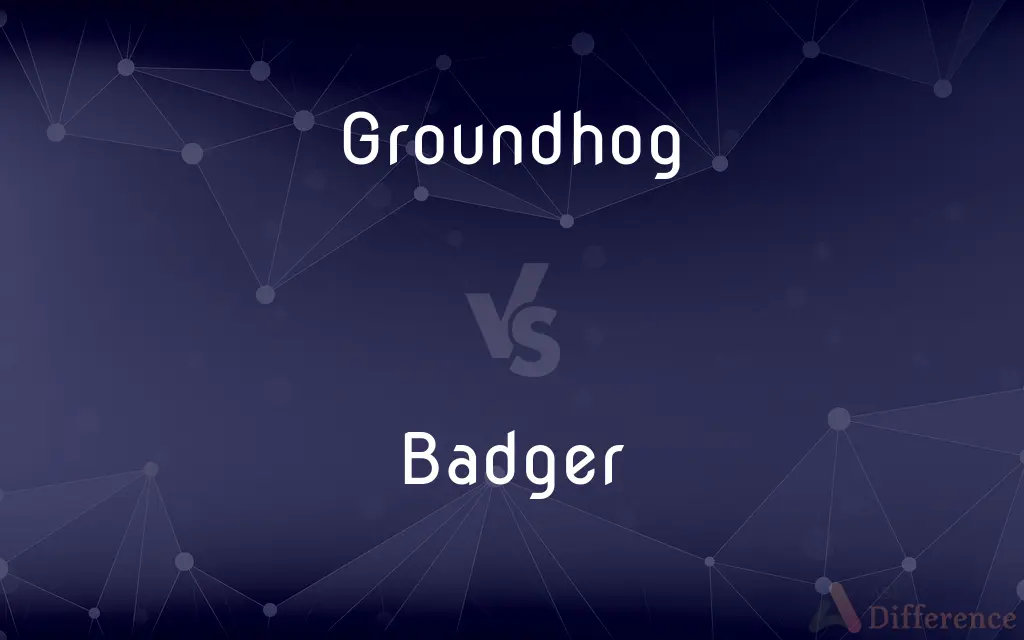Groundhog vs. Badger — What's the Difference?
By Maham Liaqat & Fiza Rafique — Updated on March 11, 2024
Groundhogs are primarily known for their burrowing habits and predicting spring's arrival, while badgers are recognized for their digging abilities and aggressive defense mechanisms.

Difference Between Groundhog and Badger
Table of Contents
ADVERTISEMENT
Key Differences
Groundhogs, also known as woodchucks, are rodents famous for their extensive burrowing activities, often creating large underground networks. Badgers, on the other hand, are part of the mustelid family, known for their powerful digging capabilities and are more diverse in habitat, ranging from open woods to plains.
While groundhogs primarily feed on vegetation, making them herbivores, badgers have a more varied diet that can include insects, small mammals, and plants, categorizing them as omnivores. This dietary difference reflects their adaptation to different ecological niches, with groundhogs affecting plant life and soil composition and badgers impacting the populations of certain pests and small animals.
Groundhogs are solitary creatures except during the breeding season, leading relatively quiet lives. In contrast, some species of badgers, such as the European badger, display more complex social structures and can live in larger, multi-generational groups called setts.
One notable cultural aspect is the North American tradition of Groundhog Day, where the groundhog's behavior is said to predict the coming of spring. Badgers, while not involved in similar folklore, hold significance in various cultures for their fierceness and resilience.
Despite their differences, both groundhogs and badgers play significant roles in their ecosystems. Groundhogs' burrowing aerates the soil, aiding in plant growth, whereas badgers control rodent and insect populations, contributing to ecological balance.
ADVERTISEMENT
Comparison Chart
Family
Rodentia (rodents)
Mustelidae (mustelids)
Diet
Herbivorous (plants, vegetables)
Omnivorous (insects, small mammals, plants)
Social Structure
Solitary (except during breeding season)
Varied, some species live in social groups
Burrowing
Extensive underground networks for living
Powerful diggers, create burrows for living and hunting
Cultural Significance
Groundhog Day predicts spring's arrival
Symbol of fierceness and resilience in various cultures
Compare with Definitions
Groundhog
Famous for the folklore of predicting spring.
The groundhog saw its shadow, signaling six more weeks of winter.
Badger
Renowned for their defensive capabilities.
A badger can fend off much larger predators.
Groundhog
Lives in extensive underground networks.
Groundhogs' burrows can have multiple entrances and chambers.
Badger
Some species live in social groups called setts.
European badgers live together in large, intricate burrow systems.
Groundhog
A North American rodent known for burrowing.
The groundhog emerged from its burrow early this year.
Badger
Omnivore with a diverse diet.
Badgers can hunt small mammals and eat berries.
Groundhog
Solitary except during mating season.
In spring, groundhogs seek out mates, breaking their usual solitude.
Badger
Holds cultural significance for resilience.
In folklore, the badger symbolizes determination and courage.
Groundhog
Herbivore that feeds on grasses and plants.
A groundhog was spotted munching on garden vegetables.
Badger
A member of the mustelid family known for digging.
The badger dug a new tunnel under the tree.
Groundhog
A reddish brown North American burrowing marmot (Marmota monax), also called the woodchuck. It hibernates in the winter.
Badger
Any of several similar mammals, such as the ratel.
Groundhog
A red-brown marmot, Marmota monax, native to North America.
Badger
To ask or nag (someone) about something in an annoying and persistent way; pester
Badgered the boy into cleaning his room.
Groundhog
(rare) The aardvark.
Badger
Any mammal of three subfamilies, which belong to the family Mustelidae: Melinae (Eurasian badgers), Mellivorinae (ratel or honey badger), and Taxideinae (American badger).
Groundhog
The groundhog (Marmota monax), also known as a woodchuck, is a rodent of the family Sciuridae, belonging to the group of large ground squirrels known as marmots. The groundhog is a lowland creature of North America; it is found through much of the eastern United States, across Canada and into Alaska.
Badger
Badgers are short-legged omnivores mostly in the family Mustelidae (which also includes the otters, polecats, weasels, and ferrets), but also with two species called "badgers" in the related family Mephitidae (which also includes the skunks). Badgers are a polyphyletic grouping, and are not a natural taxonomic grouping: badgers are united by their squat bodies, adapted for fossorial activity.
Groundhog
Another term for woodchuck
Badger
Any of several carnivorous burrowing mammals of the family Mustelidae, such as Meles meles of Eurasia or Taxidea taxus of North America, having short legs, long claws on the front feet, and a heavy grizzled coat.
Groundhog
See woodchuck.
Badger
The fur or hair of any of these mammals.
Groundhog
Reddish brown North American marmot
Badger
A native or resident of the American state, Wisconsin.
Badger
(obsolete) A brush made of badger hair.
Badger
A crew of desperate villains who robbed near rivers, into which they threw the bodies of those they murdered.
Badger
(obsolete) An itinerant licensed dealer in commodities used for food; a hawker; a huckster; -- formerly applied especially to one who bought grain in one place and sold it in another.
Badger
To pester; to annoy persistently; to press.
He kept badgering her about her bad habits.
Badger
An itinerant licensed dealer in commodities used for food; a hawker; a huckster; - formerly applied especially to one who bought grain in one place and sold it in another.
Badger
A carnivorous quadruped of the genus Meles or of an allied genus. It is a burrowing animal, with short, thick legs, and long claws on the fore feet. One species (Meles meles or Meles vulgaris), called also brock, inhabits the north of Europe and Asia; another species (Taxidea taxus or Taxidea Americana or Taxidea Labradorica) inhabits the northern parts of North America. See Teledu.
Badger
A brush made of badgers' hair, used by artists.
Badger
To tease or annoy, as a badger when baited; to worry or irritate persistently.
Badger
To beat down; to cheapen; to barter; to bargain.
Badger
Sturdy carnivorous burrowing mammal with strong claws widely distributed in the northern hemisphere
Badger
Annoy persistently;
The children teased the boy because of his stammer
Badger
Persuade through constant efforts
Common Curiosities
How do groundhogs and badgers differ in diet?
Groundhogs are herbivores, feeding primarily on vegetation, whereas badgers are omnivores, consuming insects, small mammals, and plants.
What is a badger?
A badger is a member of the mustelid family, recognized for its powerful digging abilities, varied diet, and sometimes social behavior.
What social structures do groundhogs and badgers have?
Groundhogs are mostly solitary, while some badger species, like the European badger, live in social groups known as setts.
Why is the groundhog associated with predicting spring?
The tradition of Groundhog Day involves a groundhog predicting the season's change based on whether it sees its shadow.
What role do groundhogs play in the ecosystem?
Groundhogs aerate the soil through their burrowing, which helps in plant growth and soil health.
How do groundhogs and badgers defend themselves?
Groundhogs primarily use their burrows to escape predators, whereas badgers are known to aggressively defend themselves and their homes.
Can both groundhogs and badgers dig burrows?
Yes, both are skilled diggers, but they use their burrows differently; groundhogs for living and hibernation, badgers for living and hunting.
Are groundhogs and badgers found in the same habitats?
While there can be overlap in their habitats, groundhogs are more common in North America, and badgers have a broader range, including Europe, Asia, and North America.
What is a groundhog?
A groundhog is a rodent known for its burrowing habits and significance in North American folklore, predicting the arrival of spring.
What ecological role do badgers fulfill?
Badgers control the populations of certain pests and small animals, contributing to the balance of their ecosystems.
What is the lifespan of a groundhog compared to a badger?
Lifespans vary by species, but in general, groundhogs live up to 6 years in the wild, while badgers can live up to 14 years or more, depending on the species.
Do badgers have any cultural significance?
Yes, badgers symbolize fierceness and resilience in various cultures, though they don't have a tradition akin to Groundhog Day.
What adaptations help groundhogs and badgers in their burrowing?
Groundhogs have strong legs and claws for digging and soil removal, while badgers have powerful forelimbs and sharp claws designed for efficient digging.
Are there any conservation concerns for groundhogs and badgers?
While groundhogs are generally not considered at risk, some badger species, like the honey badger, face threats from habitat loss and hunting, leading to conservation efforts.
How do groundhogs and badgers affect human activities?
Both can be seen as pests; groundhogs due to their burrowing damaging gardens and structures, and badgers for similar reasons, though badgers are also admired for their role in controlling pests.
Share Your Discovery

Previous Comparison
Slushy vs. Smoothie
Next Comparison
Lavender vs. MauveAuthor Spotlight
Written by
Maham LiaqatCo-written by
Fiza RafiqueFiza Rafique is a skilled content writer at AskDifference.com, where she meticulously refines and enhances written pieces. Drawing from her vast editorial expertise, Fiza ensures clarity, accuracy, and precision in every article. Passionate about language, she continually seeks to elevate the quality of content for readers worldwide.















































